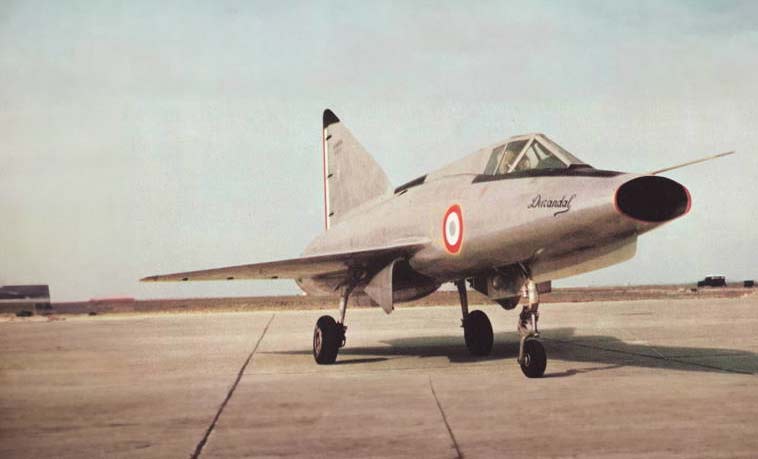The SNCASE S.E.212 Durandal was a French experimental mixed-power (jet and rocket) interceptor aircraft with a delta wing design, developed in the mid-1950s.
In Brief
The SNCASE S.E.212 Durandal was an innovative French fighter aircraft, featuring a delta wing design and a combination of jet and rocket propulsion. It was powered by a SNECMA Atar 101F turbojet engine with afterburning capabilities, delivering 9,700 pounds of thrust, complemented by a SEPR 75 rocket motor producing an additional 1,653 pounds of thrust. The Durandal had a length of 12.07 meters, a wingspan of 7.44 meters, and an empty weight of 4,575 kg. It reached a maximum speed of 1,667 km/h (1,036 mph) with the rocket at an altitude of 11,800 meters and had a climb rate of 200 m/s (39,000 ft/min). Armament options included one Nord AA.20 air-to-air missile, two 30 mm DEFA cannons, or 24 SNEB rockets. Only two prototypes were built, and the program was canceled in 1957.
The SNCASE S.E.212 Durandal represented a significant leap in aircraft design and propulsion technology, showcasing France’s post-war aviation capabilities.
History of Development
Developed during the 1950s, the SNCASE S.E.212 Durandal was part of France’s effort to rebuild its military power and produce advanced, domestically-designed aircraft. The French Air Force sought a supersonic-capable point defense interceptor, leading to the Durandal’s development. It was designed alongside lightweight fighter-bomber projects for NATO’s Basic Military Requirement 1, but the Fiat G.91 was selected over the Durandal in the competition. The Durandal’s first prototype flew on April 20, 1956, demonstrating promising results. However, the project was terminated in 1957, with critics pointing to its limited missile armament as a significant drawback.

Design
The Durandal featured a 60° delta wing and a compact design. The fuel pumps for the SEPR 75 rocket motor were driven by the jet engine, requiring the latter to run for the rocket to be ignited. The aircraft was heavier than other mixed-power prototypes and intended to fly primarily on its jet engine. Armament included a single AA.20 air-to-air missile, an alternative configuration of two 30 mm DEFA cannons, or 24 68 mm SNEB rockets. The Durandal’s design was criticized for its limited missile armament and reliance on a single opportunity to attack.
Performance
The Durandal achieved a maximum speed of 1,444 km/h (897 mph) at an altitude of 12,300 meters without the rocket motor and 1,667 km/h (1,036 mph) at 11,800 meters with the rocket active. These tests were conducted without armament. The aircraft performed 45 test flights before the program was terminated. Critics compared its capabilities unfavorably to surface-to-air missiles, contributing to its cancellation.
Variants
The SNCASE S.E.212 Durandal had two prototypes constructed, with the second prototype displayed at the Paris Air Show in 1957. No production aircraft were built, and the program was terminated before further variants could be developed.
Military Use and Combat
The Durandal did not enter military service or see combat, as its development was halted in 1957. It remains a significant example of experimental aircraft design and the exploration of mixed-power propulsion systems.
Technical Conclusion
The SNCASE S.E.212 Durandal was a notable attempt at creating a high-speed interceptor aircraft using innovative mixed-power propulsion. Although it never advanced beyond the prototype stage, its design and performance offered valuable insights into the potential of jet and rocket propulsion in fighter aircraft.
Back to the experimental aircraft section.